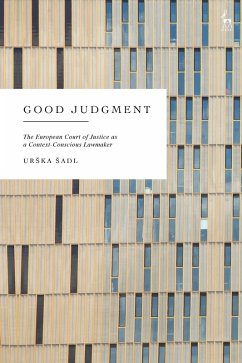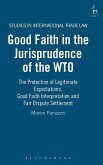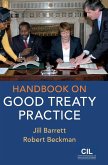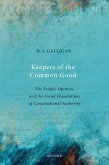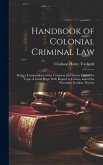- Gebundenes Buch
- Merkliste
- Auf die Merkliste
- Bewerten Bewerten
- Teilen
- Produkt teilen
- Produkterinnerung
- Produkterinnerung
Courts are context-conscious. They solve legal disputes with societal impact in mind, using interpretive tools and procedural means. This book develops concepts and methods for a systematic and legally informative analysis of this complex process. The evidence delivered prompts a conversation about the authority courts have to change the law. The analysis focuses on the European Court of Justice and its free movement case law. The framework and theory, however, are relevant to courts and case law everywhere. This is a compelling and intriguing examination of the ECJ and its shaping of a key tenet of EU law.…mehr
Andere Kunden interessierten sich auch für
![Good Faith in the Jurisprudence of the Wto Good Faith in the Jurisprudence of the Wto]() Marion PanizzonGood Faith in the Jurisprudence of the Wto158,99 €
Marion PanizzonGood Faith in the Jurisprudence of the Wto158,99 €![Judgment Day Judgment Day]() Rosa AloisiJudgment Day99,99 €
Rosa AloisiJudgment Day99,99 €![Handbook on Good Treaty Practice Handbook on Good Treaty Practice]() Jill BarrettHandbook on Good Treaty Practice165,99 €
Jill BarrettHandbook on Good Treaty Practice165,99 €![Keepers of the Common Good Keepers of the Common Good]() D J GalliganKeepers of the Common Good160,99 €
D J GalliganKeepers of the Common Good160,99 €![Handbook of Colonial Criminal Law: Being a Compendium of the Common and Statute Law of the Cape of Good Hope With Regard to Crimes, and of the Procedu Handbook of Colonial Criminal Law: Being a Compendium of the Common and Statute Law of the Cape of Good Hope With Regard to Crimes, and of the Procedu]() Clarkson Henry TredgoldHandbook of Colonial Criminal Law: Being a Compendium of the Common and Statute Law of the Cape of Good Hope With Regard to Crimes, and of the Procedu37,99 €
Clarkson Henry TredgoldHandbook of Colonial Criminal Law: Being a Compendium of the Common and Statute Law of the Cape of Good Hope With Regard to Crimes, and of the Procedu37,99 €![The Art and Craft of Judgment Writing The Art and Craft of Judgment Writing]() Max BarrettThe Art and Craft of Judgment Writing176,99 €
Max BarrettThe Art and Craft of Judgment Writing176,99 €![The Practice On Signing Judgment in the High Court of Justice The Practice On Signing Judgment in the High Court of Justice]() H H WalkerThe Practice On Signing Judgment in the High Court of Justice29,99 €
H H WalkerThe Practice On Signing Judgment in the High Court of Justice29,99 €-
-
-
Courts are context-conscious. They solve legal disputes with societal impact in mind, using interpretive tools and procedural means. This book develops concepts and methods for a systematic and legally informative analysis of this complex process. The evidence delivered prompts a conversation about the authority courts have to change the law. The analysis focuses on the European Court of Justice and its free movement case law. The framework and theory, however, are relevant to courts and case law everywhere. This is a compelling and intriguing examination of the ECJ and its shaping of a key tenet of EU law.
Produktdetails
- Produktdetails
- Verlag: Bloomsbury 3PL
- Seitenzahl: 230
- Erscheinungstermin: 1. August 2024
- Englisch
- Abmessung: 240mm x 161mm x 17mm
- Gewicht: 514g
- ISBN-13: 9781509968121
- ISBN-10: 1509968121
- Artikelnr.: 69640257
- Herstellerkennzeichnung
- Libri GmbH
- Europaallee 1
- 36244 Bad Hersfeld
- gpsr@libri.de
- Verlag: Bloomsbury 3PL
- Seitenzahl: 230
- Erscheinungstermin: 1. August 2024
- Englisch
- Abmessung: 240mm x 161mm x 17mm
- Gewicht: 514g
- ISBN-13: 9781509968121
- ISBN-10: 1509968121
- Artikelnr.: 69640257
- Herstellerkennzeichnung
- Libri GmbH
- Europaallee 1
- 36244 Bad Hersfeld
- gpsr@libri.de
Urska Sadl is Part-time Professor at the European University Institute, Italy, and Associate Professor at the Faculty of Law, University of Copenhagen, Denmark.
1. Introduction
a. The Main Claim
b. The Structure
i. The Premise
ii. Contribution
c. The Outline
d. In Sum
Part One: The Analytical Framework
2. Context Conscious Judging
a. Four Perspectives on Context Conscious Judging
i. Maximising Legal Values with Sound Legal Arguments
ii. Maximising Power with Strategic Solutions
iii. Maintaining Authority
iv. Minimising Conflict by Muddling Through
b. The Court's Context Conscious Reasoning and Political Power
3. Good Judgement
a. From Context Conscious Judging to Good Judgment
i. The Baseline: Model Application of Law and the Structure of Typical
Justification
ii. Non-binary Decisions: An Illustration
iii. Conflicting Interests
iv. Distinctions
b. Three Types of Good Judgment
c. Conclusion
4. Operationalising Good Judgment
a. Three Steps of the Analysis
b. The Parameters of Case Law
i. Legal Characteristics
ii. Case Characteristics
c. Annotation of Judgments
Conclusion to Part One
Part Two: The Mechanics of Good Judgment
5. Persons
a. Introduction
b. The Rules Governing the Free Movement of Persons and European Citizens
i. Treaty Rights, Legislative Acts, and the Competence to Regulate Free
Movement
ii. Citizenship Rights Directive: Consolidating Legislative Instruments,
Case Law and Conflict
c. Free Movement Disputes: Legal Issues
d. The Parameters of Good Judgement
i. Non-sanctioning Europeanisation of National Policies through the Prism
of Proportionality, Discrimination and Compatibility Review
ii. Individual Protection and Deferral of Authority in Judgments Upholding
European Rights and Principles
iii. Preserving State Autonomy in Judgments Advancing Free Movement of
Persons Law
iv. Relevant Information About Free Movement of Persons Cases
e. Emblematic Judgments: Facts, Justification, Context, Implications
i. Non-sanctioning Europeanisation of National Policies
ii. Deferential Upholding of European Rights
iii. Bounded Undesirable Interpretation
f. Upholding Conflicting Interests - The Long Term 1954 - 2022
6. Goods
a. Introduction
b. The Legal Framework of Free Movement of Goods
i. The Ambiguous Heart of the System
ii. Rights at Stake and Interests at Play in the Case-law
c. Free Movement Judgments: An Overview of Legal Questions
d. The Parameters of Good Judgment
i. Non-sanctioning Europeanisation of National Policies through the Prism
of Proportionality, Discrimination and Compatibility Review
ii. Deferral of Authority in Judgments Upholding Free Movement Rights and
Principles
iii. Preserving State Autonomy in Judgments Advancing Free Movement of
Goods: Bounded Undesirable Interpretation
iv. Relevant Information about Free Movement of Good Cases
e. Emblematic Judgments: A Close Up
i. The Non-sanctioning Europeanisation of National Policies
ii. The Deferential Upholding of Free Movement Rights
iii. The Bounded Undesirable Interpretation
f. Upholding Conflicting Interests: The Long Term
Part Three: The Mechanisms of Good Judgment
Introduction
i. Main Finding
ii. Unpacking the Findings: The Roadmap
a. Case Motivated Good Judgment
i. The Applicants
ii. The Case
iii. The Institution (Idiosyncratic Good Judgment)
b. Context-Motivated Good Judgment
i. Recognising the Stakes
ii. Honouring Fragile Consensus/Equilibrium
iii. Adjusting to the Climate
c. Alternative Tools of Context Conscious Judging
i. Reframing Disputes
ii. Mixed Signals
iii. Low Stakes/Waiting for the Tide to Turn
d. Appraisal
8. Conclusion
a. Summary of the Argument
b. Contribution
c. Is Good Judgment a Good Idea?
a. The Main Claim
b. The Structure
i. The Premise
ii. Contribution
c. The Outline
d. In Sum
Part One: The Analytical Framework
2. Context Conscious Judging
a. Four Perspectives on Context Conscious Judging
i. Maximising Legal Values with Sound Legal Arguments
ii. Maximising Power with Strategic Solutions
iii. Maintaining Authority
iv. Minimising Conflict by Muddling Through
b. The Court's Context Conscious Reasoning and Political Power
3. Good Judgement
a. From Context Conscious Judging to Good Judgment
i. The Baseline: Model Application of Law and the Structure of Typical
Justification
ii. Non-binary Decisions: An Illustration
iii. Conflicting Interests
iv. Distinctions
b. Three Types of Good Judgment
c. Conclusion
4. Operationalising Good Judgment
a. Three Steps of the Analysis
b. The Parameters of Case Law
i. Legal Characteristics
ii. Case Characteristics
c. Annotation of Judgments
Conclusion to Part One
Part Two: The Mechanics of Good Judgment
5. Persons
a. Introduction
b. The Rules Governing the Free Movement of Persons and European Citizens
i. Treaty Rights, Legislative Acts, and the Competence to Regulate Free
Movement
ii. Citizenship Rights Directive: Consolidating Legislative Instruments,
Case Law and Conflict
c. Free Movement Disputes: Legal Issues
d. The Parameters of Good Judgement
i. Non-sanctioning Europeanisation of National Policies through the Prism
of Proportionality, Discrimination and Compatibility Review
ii. Individual Protection and Deferral of Authority in Judgments Upholding
European Rights and Principles
iii. Preserving State Autonomy in Judgments Advancing Free Movement of
Persons Law
iv. Relevant Information About Free Movement of Persons Cases
e. Emblematic Judgments: Facts, Justification, Context, Implications
i. Non-sanctioning Europeanisation of National Policies
ii. Deferential Upholding of European Rights
iii. Bounded Undesirable Interpretation
f. Upholding Conflicting Interests - The Long Term 1954 - 2022
6. Goods
a. Introduction
b. The Legal Framework of Free Movement of Goods
i. The Ambiguous Heart of the System
ii. Rights at Stake and Interests at Play in the Case-law
c. Free Movement Judgments: An Overview of Legal Questions
d. The Parameters of Good Judgment
i. Non-sanctioning Europeanisation of National Policies through the Prism
of Proportionality, Discrimination and Compatibility Review
ii. Deferral of Authority in Judgments Upholding Free Movement Rights and
Principles
iii. Preserving State Autonomy in Judgments Advancing Free Movement of
Goods: Bounded Undesirable Interpretation
iv. Relevant Information about Free Movement of Good Cases
e. Emblematic Judgments: A Close Up
i. The Non-sanctioning Europeanisation of National Policies
ii. The Deferential Upholding of Free Movement Rights
iii. The Bounded Undesirable Interpretation
f. Upholding Conflicting Interests: The Long Term
Part Three: The Mechanisms of Good Judgment
Introduction
i. Main Finding
ii. Unpacking the Findings: The Roadmap
a. Case Motivated Good Judgment
i. The Applicants
ii. The Case
iii. The Institution (Idiosyncratic Good Judgment)
b. Context-Motivated Good Judgment
i. Recognising the Stakes
ii. Honouring Fragile Consensus/Equilibrium
iii. Adjusting to the Climate
c. Alternative Tools of Context Conscious Judging
i. Reframing Disputes
ii. Mixed Signals
iii. Low Stakes/Waiting for the Tide to Turn
d. Appraisal
8. Conclusion
a. Summary of the Argument
b. Contribution
c. Is Good Judgment a Good Idea?
1. Introduction
a. The Main Claim
b. The Structure
i. The Premise
ii. Contribution
c. The Outline
d. In Sum
Part One: The Analytical Framework
2. Context Conscious Judging
a. Four Perspectives on Context Conscious Judging
i. Maximising Legal Values with Sound Legal Arguments
ii. Maximising Power with Strategic Solutions
iii. Maintaining Authority
iv. Minimising Conflict by Muddling Through
b. The Court's Context Conscious Reasoning and Political Power
3. Good Judgement
a. From Context Conscious Judging to Good Judgment
i. The Baseline: Model Application of Law and the Structure of Typical
Justification
ii. Non-binary Decisions: An Illustration
iii. Conflicting Interests
iv. Distinctions
b. Three Types of Good Judgment
c. Conclusion
4. Operationalising Good Judgment
a. Three Steps of the Analysis
b. The Parameters of Case Law
i. Legal Characteristics
ii. Case Characteristics
c. Annotation of Judgments
Conclusion to Part One
Part Two: The Mechanics of Good Judgment
5. Persons
a. Introduction
b. The Rules Governing the Free Movement of Persons and European Citizens
i. Treaty Rights, Legislative Acts, and the Competence to Regulate Free
Movement
ii. Citizenship Rights Directive: Consolidating Legislative Instruments,
Case Law and Conflict
c. Free Movement Disputes: Legal Issues
d. The Parameters of Good Judgement
i. Non-sanctioning Europeanisation of National Policies through the Prism
of Proportionality, Discrimination and Compatibility Review
ii. Individual Protection and Deferral of Authority in Judgments Upholding
European Rights and Principles
iii. Preserving State Autonomy in Judgments Advancing Free Movement of
Persons Law
iv. Relevant Information About Free Movement of Persons Cases
e. Emblematic Judgments: Facts, Justification, Context, Implications
i. Non-sanctioning Europeanisation of National Policies
ii. Deferential Upholding of European Rights
iii. Bounded Undesirable Interpretation
f. Upholding Conflicting Interests - The Long Term 1954 - 2022
6. Goods
a. Introduction
b. The Legal Framework of Free Movement of Goods
i. The Ambiguous Heart of the System
ii. Rights at Stake and Interests at Play in the Case-law
c. Free Movement Judgments: An Overview of Legal Questions
d. The Parameters of Good Judgment
i. Non-sanctioning Europeanisation of National Policies through the Prism
of Proportionality, Discrimination and Compatibility Review
ii. Deferral of Authority in Judgments Upholding Free Movement Rights and
Principles
iii. Preserving State Autonomy in Judgments Advancing Free Movement of
Goods: Bounded Undesirable Interpretation
iv. Relevant Information about Free Movement of Good Cases
e. Emblematic Judgments: A Close Up
i. The Non-sanctioning Europeanisation of National Policies
ii. The Deferential Upholding of Free Movement Rights
iii. The Bounded Undesirable Interpretation
f. Upholding Conflicting Interests: The Long Term
Part Three: The Mechanisms of Good Judgment
Introduction
i. Main Finding
ii. Unpacking the Findings: The Roadmap
a. Case Motivated Good Judgment
i. The Applicants
ii. The Case
iii. The Institution (Idiosyncratic Good Judgment)
b. Context-Motivated Good Judgment
i. Recognising the Stakes
ii. Honouring Fragile Consensus/Equilibrium
iii. Adjusting to the Climate
c. Alternative Tools of Context Conscious Judging
i. Reframing Disputes
ii. Mixed Signals
iii. Low Stakes/Waiting for the Tide to Turn
d. Appraisal
8. Conclusion
a. Summary of the Argument
b. Contribution
c. Is Good Judgment a Good Idea?
a. The Main Claim
b. The Structure
i. The Premise
ii. Contribution
c. The Outline
d. In Sum
Part One: The Analytical Framework
2. Context Conscious Judging
a. Four Perspectives on Context Conscious Judging
i. Maximising Legal Values with Sound Legal Arguments
ii. Maximising Power with Strategic Solutions
iii. Maintaining Authority
iv. Minimising Conflict by Muddling Through
b. The Court's Context Conscious Reasoning and Political Power
3. Good Judgement
a. From Context Conscious Judging to Good Judgment
i. The Baseline: Model Application of Law and the Structure of Typical
Justification
ii. Non-binary Decisions: An Illustration
iii. Conflicting Interests
iv. Distinctions
b. Three Types of Good Judgment
c. Conclusion
4. Operationalising Good Judgment
a. Three Steps of the Analysis
b. The Parameters of Case Law
i. Legal Characteristics
ii. Case Characteristics
c. Annotation of Judgments
Conclusion to Part One
Part Two: The Mechanics of Good Judgment
5. Persons
a. Introduction
b. The Rules Governing the Free Movement of Persons and European Citizens
i. Treaty Rights, Legislative Acts, and the Competence to Regulate Free
Movement
ii. Citizenship Rights Directive: Consolidating Legislative Instruments,
Case Law and Conflict
c. Free Movement Disputes: Legal Issues
d. The Parameters of Good Judgement
i. Non-sanctioning Europeanisation of National Policies through the Prism
of Proportionality, Discrimination and Compatibility Review
ii. Individual Protection and Deferral of Authority in Judgments Upholding
European Rights and Principles
iii. Preserving State Autonomy in Judgments Advancing Free Movement of
Persons Law
iv. Relevant Information About Free Movement of Persons Cases
e. Emblematic Judgments: Facts, Justification, Context, Implications
i. Non-sanctioning Europeanisation of National Policies
ii. Deferential Upholding of European Rights
iii. Bounded Undesirable Interpretation
f. Upholding Conflicting Interests - The Long Term 1954 - 2022
6. Goods
a. Introduction
b. The Legal Framework of Free Movement of Goods
i. The Ambiguous Heart of the System
ii. Rights at Stake and Interests at Play in the Case-law
c. Free Movement Judgments: An Overview of Legal Questions
d. The Parameters of Good Judgment
i. Non-sanctioning Europeanisation of National Policies through the Prism
of Proportionality, Discrimination and Compatibility Review
ii. Deferral of Authority in Judgments Upholding Free Movement Rights and
Principles
iii. Preserving State Autonomy in Judgments Advancing Free Movement of
Goods: Bounded Undesirable Interpretation
iv. Relevant Information about Free Movement of Good Cases
e. Emblematic Judgments: A Close Up
i. The Non-sanctioning Europeanisation of National Policies
ii. The Deferential Upholding of Free Movement Rights
iii. The Bounded Undesirable Interpretation
f. Upholding Conflicting Interests: The Long Term
Part Three: The Mechanisms of Good Judgment
Introduction
i. Main Finding
ii. Unpacking the Findings: The Roadmap
a. Case Motivated Good Judgment
i. The Applicants
ii. The Case
iii. The Institution (Idiosyncratic Good Judgment)
b. Context-Motivated Good Judgment
i. Recognising the Stakes
ii. Honouring Fragile Consensus/Equilibrium
iii. Adjusting to the Climate
c. Alternative Tools of Context Conscious Judging
i. Reframing Disputes
ii. Mixed Signals
iii. Low Stakes/Waiting for the Tide to Turn
d. Appraisal
8. Conclusion
a. Summary of the Argument
b. Contribution
c. Is Good Judgment a Good Idea?

